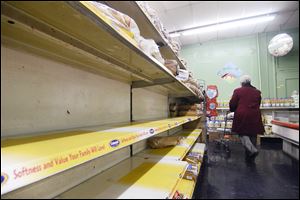
WEATHER
‘Wicked winter’ has big impact on business
Restaurants can’t make up lost sales
2/26/2014
The bread shelves at Buehler's Market in Chattanooga, Tenn. are mostly empty. Owner Charles Morton says he has been in the business for 50 years, and the bread and milk sales have always increased in snow.
PITTSBURGH — Joe Pawlak, who has been in the food service business for 25 years, doesn’t hesitate to label this one of the worst winters for restaurants and other food operators: “This is as bad as I’ve seen it.”
Next week, the senior vice president of Chicago-based food consulting group Technomic Inc. will lead a Webinar titled “The Wicked Winter of 2014: Impact on Consumer Eating Out and Operator Sales.”
There have been a lot of names given to the winter of 2013-14 — few of them complimentary — but economic analysts are still waiting to gauge the final impact of the meteorological misery.
Snow, ice, and frigid temperatures are a factor in slowing down many businesses — keeping cars sitting on dealers’ lots, stalling sales of existing homes, fewer gamblers going to casinos, shipping companies struggling to get deliveries out, and retailers waiting by the door for customers.
But that’s the short term. The longer term implications for the economy are less clear. Analysts say some sectors may be able to shrug it off as temperatures warm up, while others could have a harder time recovering.
Restaurants, for example, can’t make up lost dinner checks in the same way that a car dealer might make up a lost sale. A meal eaten elsewhere is done and over.
“You’ve lost all those opportunities,” said Mr. Pawlak.
Technomic is in the midst of surveying restaurants, hotels, and school cafeteria operators to see if it will need to pull back on the projection it issued in January for 3.5 percent growth industrywide this year.
And winter is not even over yet.
Matt Rogers, founder and president of Bethesda, Md.-based Commodity Weather Group, late last week was looking for two to three more weeks of “impressive cold.” His consulting firm works with about 240 companies — ranging from hedge funds to banks, food companies, and utilities — that are affected by shifting energy and food prices.
“It’s been a crazy winter,” Mr. Rogers said.
Last fall, the firm forecast a colder winter than the previous one, but the season has exceeded expectations.
Mr. Rogers said the period from Dec. 1 through the end of February has been the coldest since the 1981-82 season.
“It’s having some very important impacts.”
Natural gas prices are up under the weight of the demand, although the influx of natural gas from sources like the Marcellus Shale region that underlies much of Pennsylvania has helped avoid a shortage.
“It could have been a lot worse,” Mr. Rogers said, noting that a 2003 winter that wasn’t this cold caused a scare about the natural gas supply.
Winter wheat — wheat that’s planted in the fall, goes dormant in the winter and then is harvested after growing again in the spring — could be threatened by this latest round of extreme cold temperatures, said Joel Widenor, founder, vice president, and director of agricultural services for Commodity Weather Group.
So far crops growing in states such as Nebraska, Kansas, and Indiana have avoided great damage because of snow that creates a sort of blanket, protecting the dormant wheat, Mr. Widenor said.
But that big melting period last week that gave some relief to stores, restaurants, and shippers could hurt the farmers — and in turn the commercial bakers who rely on that wheat.
Which is a reminder that there are winners and losers in everything.
“We’re seeing exponentially more activity from winter-focused clients,” said Joe DeRugeriis, director of marketing for Planalytics, a business weather intelligence company near Philadelphia. Anyone selling things like snowblowers, shovels, outerwear, and scarves has been OK with the stormy weather — to a point.
Findlay retailer Dick’s Sporting Goods, a Planalytics customer that includes snow gear and coats in its inventory, earlier this month raised its earnings projections for the quarter that ended Feb. 1. In previous warmer winters, Dick’s has been stuck with cold weather inventory.
Still, the economic fog from the storms hasn’t cleared.
“Harsh winter weather is masking the performance of the broader economy,” complained the National Retail Federation’s chief economist Jack Kleinhenz, in a mid-February report on January’s numbers.
“Extreme temperatures and severe ice and snow are making it increasingly difficult to assess if the retail sales slowdown is temporary or a telling sign of a longer lasting weakness in the consumer-fueled economy. No one can jump to any solid conclusion until we shovel out of the snow.”
That effort to see further out has broader implications, too.
The stock markets took a chill in early February after the Institute for Supply Management issued a report that showed, among other things, new orders in the manufacturing sector had dropped 13.2 percentage points from December, an “almost unprecedented” drop, according to Bradley J. Holcomb, chairman of the ISM’s manufacturing business survey committee.
Weather that closed some businesses and slowed deliveries was probably a factor in that number, he said, as well as in the 6.9 percentage point drop in production during the month.
Yet, said Mr. Holcomb, “All things considered, my sense is this is a short-term blip and it will be made up.”
The Block News Alliance consists of The Blade and the Pittsburgh Post-Gazette. Teresa F. Lindeman is a reporter for the Post-Gazette.
Contact Teresa F. Lindeman: tlindeman@post-gazette.com or 412-263-2018.